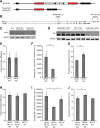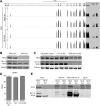NF45 and NF90/NF110 coordinately regulate ESC pluripotency and differentiation
- PMID: 28487382
- PMCID: PMC5513071
- DOI: 10.1261/rna.061499.117
NF45 and NF90/NF110 coordinately regulate ESC pluripotency and differentiation
Abstract
While years of investigation have elucidated many aspects of embryonic stem cell (ESC) regulation, the contributions of post-transcriptional and translational mechanisms to the pluripotency network remain largely unexplored. In particular, little is known in ESCs about the function of RNA binding proteins (RBPs), the protein agents of post-transcriptional regulation. We performed an unbiased RNAi screen of RBPs in an ESC differentiation assay and identified two related genes, NF45 (Ilf2) and NF90/NF110 (Ilf3), whose knockdown promoted differentiation to an epiblast-like state. Characterization of NF45 KO, NF90 + NF110 KO, and NF110 KO ESCs showed that loss of NF45 or NF90 + NF110 impaired ESC proliferation and led to dysregulated differentiation down embryonic lineages. Additionally, we found that NF45 and NF90/NF110 physically interact and influence the expression of each other at different levels of regulation. Globally across the transcriptome, NF45 KO ESCs and NF90 + NF110 KO ESCs show similar expression changes. Moreover, NF90 + NF110 RNA immunoprecipitation (RIP)-seq in ESCs suggested that NF90/NF110 directly regulate proliferation, differentiation, and RNA-processing genes. Our data support a model in which NF45, NF90, and NF110 operate in feedback loops that enable them, through both overlapping and independent targets, to help balance the push and pull of pluripotency and differentiation cues.
Keywords: NF45; NF90/NF110; RNA-binding protein; pluripotency; post-transcriptional regulation.
© 2017 Ye et al.; Published by Cold Spring Harbor Laboratory Press for the RNA Society.
Figures







Similar articles
-
Inducible expression of immediate early genes is regulated through dynamic chromatin association by NF45/ILF2 and NF90/NF110/ILF3.PLoS One. 2019 Apr 25;14(4):e0216042. doi: 10.1371/journal.pone.0216042. eCollection 2019. PLoS One. 2019. PMID: 31022259 Free PMC article.
-
Nuclear factor 45 (NF45) is a regulatory subunit of complexes with NF90/110 involved in mitotic control.Mol Cell Biol. 2008 Jul;28(14):4629-41. doi: 10.1128/MCB.00120-08. Epub 2008 May 5. Mol Cell Biol. 2008. PMID: 18458058 Free PMC article.
-
The RNA binding complexes NF45-NF90 and NF45-NF110 associate dynamically with the c-fos gene and function as transcriptional coactivators.J Biol Chem. 2015 Oct 30;290(44):26832-45. doi: 10.1074/jbc.M115.688317. Epub 2015 Sep 17. J Biol Chem. 2015. PMID: 26381409 Free PMC article.
-
Ilf3 and NF90 functions in RNA biology.Wiley Interdiscip Rev RNA. 2015 Mar-Apr;6(2):243-56. doi: 10.1002/wrna.1270. Epub 2014 Oct 18. Wiley Interdiscip Rev RNA. 2015. PMID: 25327818 Review.
-
Regulatory role of Klf5 in early mouse development and in embryonic stem cells.Vitam Horm. 2011;87:381-97. doi: 10.1016/B978-0-12-386015-6.00037-8. Vitam Horm. 2011. PMID: 22127252 Review.
Cited by
-
Arrayed functional genetic screenings in pluripotency reprogramming and differentiation.Stem Cell Res Ther. 2019 Jan 11;10(1):24. doi: 10.1186/s13287-018-1124-6. Stem Cell Res Ther. 2019. PMID: 30635073 Free PMC article. Review.
-
Genome-wide identification and functional analysis of dysregulated alternative splicing profiles in sepsis.J Inflamm (Lond). 2023 Sep 25;20(1):31. doi: 10.1186/s12950-023-00355-w. J Inflamm (Lond). 2023. PMID: 37749550 Free PMC article.
-
The lncRNA SNHG26 drives the inflammatory-to-proliferative state transition of keratinocyte progenitor cells during wound healing.Nat Commun. 2024 Oct 5;15(1):8637. doi: 10.1038/s41467-024-52783-8. Nat Commun. 2024. PMID: 39366968 Free PMC article.
-
Interleukin enhancer binding factor 2 is a prognostic biomarker for breast cancer that also predicts neoadjuvant chemotherapy responses.Am J Transl Res. 2018 Jun 15;10(6):1677-1689. eCollection 2018. Am J Transl Res. 2018. PMID: 30018709 Free PMC article.
-
The highly conserved PIWI-interacting RNA CRAPIR antagonizes PA2G4-mediated NF110-NF45 disassembly to promote heart regeneration in mice.Nat Cardiovasc Res. 2025 Jan;4(1):102-118. doi: 10.1038/s44161-024-00592-z. Epub 2025 Jan 15. Nat Cardiovasc Res. 2025. PMID: 39814981
References
-
- Baltz AG, Munschauer M, Schwanhausser B, Vasile A, Murakawa Y, Schueler M, Youngs N, Penfold-Brown D, Drew K, Milek M, et al. 2012. The mRNA-bound proteome and its global occupancy profile on protein-coding transcripts. Mol Cell 46: 674–690. - PubMed
-
- Castello A, Fischer B, Eichelbaum K, Horos R, Beckmann BM, Strein C, Davey NE, Humphreys DT, Preiss T, Steinmetz LM, et al. 2012. Insights into RNA biology from an atlas of mammalian mRNA-binding proteins. Cell 149: 1393–1406. - PubMed
Publication types
MeSH terms
Substances
Grants and funding
LinkOut - more resources
Full Text Sources
Other Literature Sources
Molecular Biology Databases
Research Materials
Miscellaneous
